FAQ
- Bolivia climbing questions
-
Mallorca island and rockclimbing
- What are main specifics of rockclimbing trip to Mallorca
- Mallorca island impressions
- Rockclimbing safety Spain
- Mallorca climbing accommodation
- What season is possible for rockclimbing in Mallorca
- Transport accessibility of climbing sectors in Mallorca
- Active vacation in Mallorca
- Saint Anthony night in Mallorca
- Peru climbing questions
- Gear reviews
-
Safety in the mountains
- How NOT to climb the summit?
- Mountain navigation
- At the limit of possibilities
- Mountain thunderstorm
- Solo ascents and mountain trips alone
- Mutual responsibility in mountaineering
- Safety illusions in the mountains - a rope
- Independent team of two
- Mountain troubles
- Psychological problems in the mountains
- Health in the mountains
-
Elbrus questions
- Elbrus climbing gear
- Climbing Elbrus with children?
- Mount Elbrus location?
- Elbrus logistics
- How to get to Mount Elbrus?
- Elbrus German airfield?
- Elbrus difficulty grade
- 5 points beginner must know about Elbrus
- How to prepare for Elbrus?
- Are there avalanches on Mount Elbrus?
- Climbing Elbrus solo?
- Seasonality of climbing Mount Elbrus
- How much time climbing Elbrus takes?
- Clothes for Mount Elbrus?
- Pressure at the top of Elbrus?
- Elbrus air temperature
- Elbrus sightseeing
- How much to climb Elbrus
- Gear questions
- Mountaineering questions
- Mountain climbing training
-
Rockclimbing questions
- Rockclimbing gear
- How to choose your first rockclimbing shoes
- The hand power in roclcimbing
- What is Rockclimbing tours
- Non olymnic rockclimbing
- What is rockclimbing?
- Where do you climb?
- Where and when we organize our rockclimbing programs?
- What is rockclimbing?
- Rockcliming program class?
- Climbing motivation
- Horse riding tours
- Iceclimbing questions
-
Questions on the alpine programs
- What to climb in Morocco?
- Weekend summit climb
- Georgia 2023
- Pico Aneto - what is that mountain?
- Mountain programs format
- Mountain climbing food ration
- Queries on the alpine program climbing Mount Bazarduzu
- Queries on the Kamchatka alpine program climbing
- What is combined program?
- What is sightseeing program?
- What is pilot program?
- What programs you have of the medium complexity level?
- Basic expedition rations
- Prices for the mountain climbing programs
- Queries on the Mountain Course in Adyl Su valley
- Program complexity?
- Questions about MCS AlexClimb
- Questions related to trekking programs
Questions related to trekking programs
Trekking, hiking and mountaineering
Read in Telegram in English
Leer en Telegram en Español
Mountain trekking programs of MCS AlexClimb
What is trekking and hiking? What are the similarities and differences between these types of outdoor activities?
Which mountain programs from the MCS AlexClimb collection relate to the trekking category?
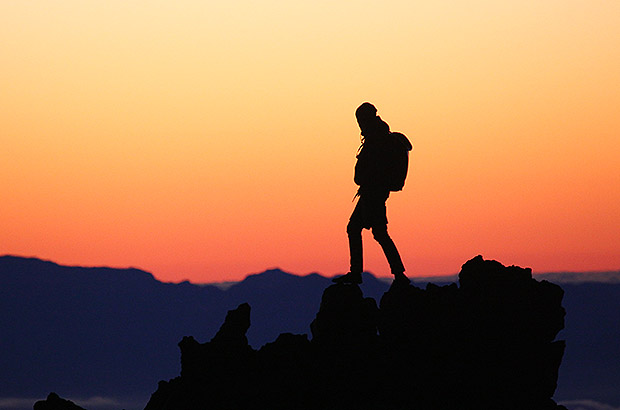
Mountain trekking route at the foot of the Teide volcano, Tenerife island
In mountaineering terminology, trekking usually refers to mountain walking routes of varying difficulty, lasting more than 1 day. The main difference between trekking and mountaineering is that the goal of the trekking route is not always to climb to the summit.

On a trekking route on Mount Kenya, Africa
Trekking is the most accessible form of mountain travel that does not require special training.
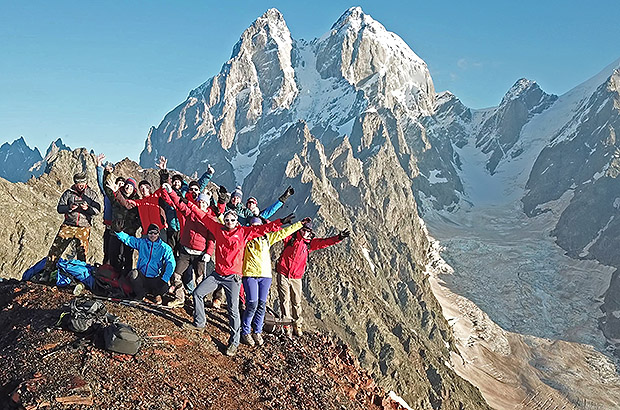
On a trekking route in Svanetia, Georgia
To avoid misunderstanding, I will define another term that is often confused with the concept of trekking - although this is not exactly the same thing. Hiking - that is walking on a short, uncomplicated routes lasting no more than 1 day, it is not associated with the need to organize overnight stays or cover significant distances.
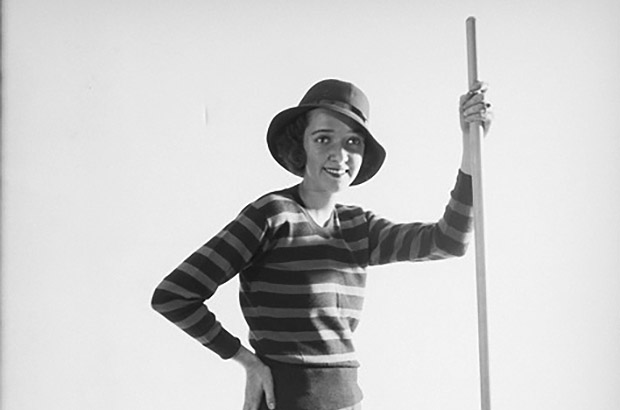
Classic clothing for hiking
This type of outdoor activity appeared in Europe in the 18th century and was positioned as a “pleasant walk in nature.” We use numerous variations of hiking routes in our active programs in the European Alps, the Caucasus, Armenia, Mallorca, Tenerife, etc. Hiking routes are not of interest as independent full time activities.
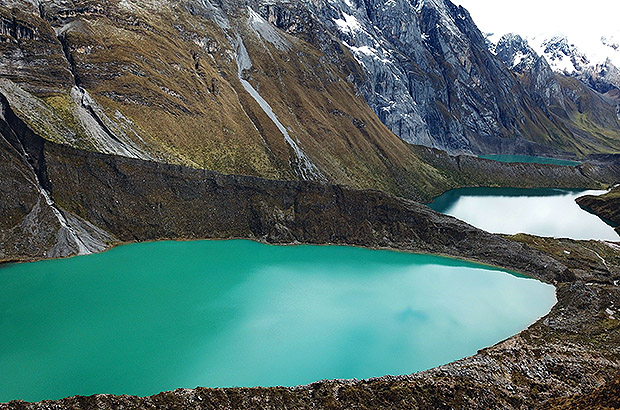
On the trekking route in Cordillera Huayhuash, Peru
In addition, many entry-level mountain routes are formally classified as trekking routes, since they do not present any technical difficulties for climbing. However, when using the term “trekking” in relation to a mountaineering route, it should be understood that this is just an assessment of the low technical complexity of the mountaineering route.
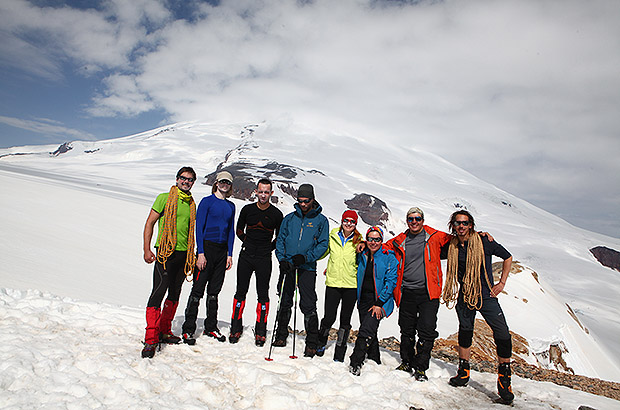
On the trekking route at the foot of Mount Elbrus, Caucasus
In addition to technical difficulties, climbing summit may have other difficulties and dangers inherent in mountaineering. “Trekking” mountaineering routes include many routes of initial difficulty category - Mount Elbrus, Mount Kilimanjaro, Peak Kosciuszko, Cerro Aconcagua, Nevado Ojos del Salado, Mount Bazarduzu, Mount Ararat, Teide Volcano and many other peaks, for which no equipment is required for climbing, or just a minimal set of climbing gear is used.
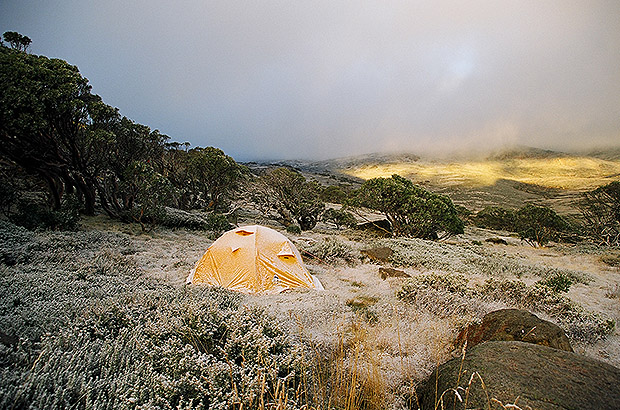
On the trekking route to Peak Kosciuszko, Australia
Mountain programs in the trekking category are not included in the main thematic group of the mountain travel, which is carried out by the MCS AlexClimb School. Our specialization for many years has been focused on the technical programs in mountaineering, rockclimbing and iceclimbing.
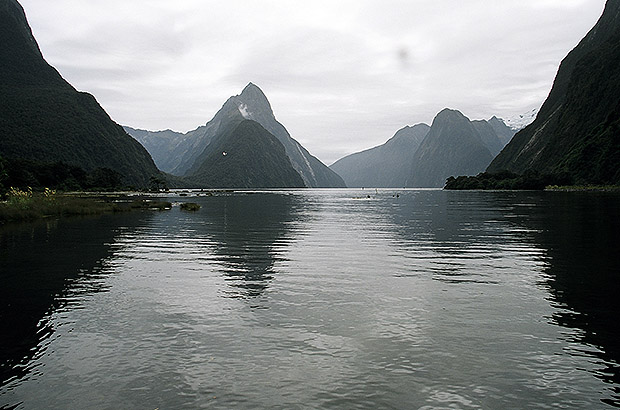
Beautiful trekking in the Milford Sound fjord in New Zealand, after climbing Mount Cook
However, in some cases it becomes necessary to conduct easy trekking programs in the mountains. In particular, this may be due to the need for high-altitude acclimatization, splitting the group (if not all participants are ready for difficult climbs), adding extra 2-3-day activities in rockclimbing or iceclimbing programs in order to diversify the daily training routine.
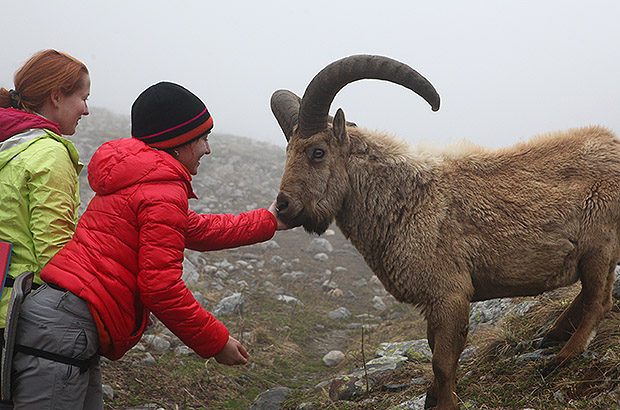
Communication with wildlife while trekking in the Bezengi region
Thus, we have naturally formed a small set of interesting, non-trivial trekking routes that are related with activity in the mountains, but are not associated with climbing summits. We have placed these programs in a separate category “Mountain Trekking”.
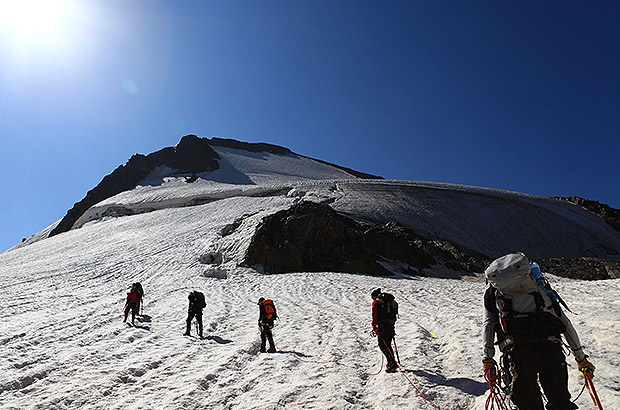
Trekking climb of Mount Laila in Svanetia, Georgia
Programs in this Trekking category are divided into two groups – “serviced” and “unserviced” trekking.
“Serviced” trekking routes are the most relaxed and most comfortable form of mountain travel. Pack animals or porters are used to transport cargo; food preparation, setting up camps and other group duties are performed by the personnel accompanying the group.
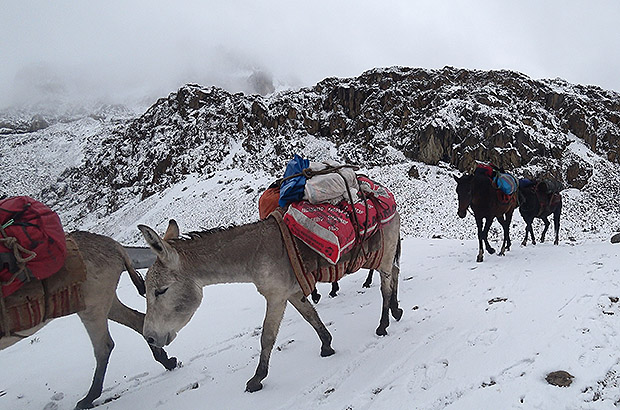
On the trekking route in Cordillera Huayhuash, Peru
This is the most comfortable and safe format of travel in the mountains, physical activity on these routes is minimal, the level of comfort is the highest possible in the format of a mountain travel. A good example of this category is our 11-day circular trekking route in Cordillera Huayhuash, Peru.
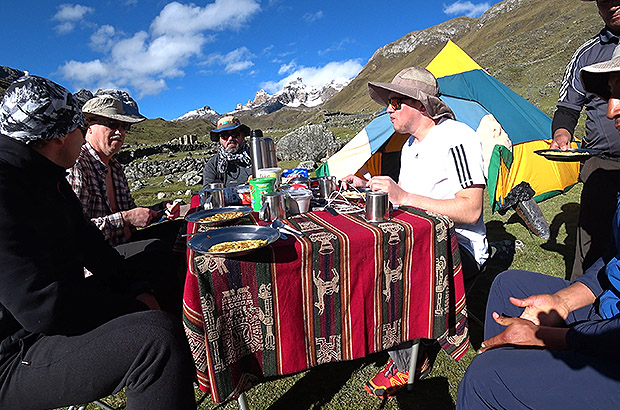
Breakfast during an serviced trekking in Cordillera Huayhuash, Peru
Or the shorter Santa Cruz trekking route. Participation in the “serviced” trekking programs is available without restrictions on age or skill level. (children can only participate if accompanied by their parents)
The category of “unserviced” treks includes routes on which it is impossible or difficult to organize support for the group by additional personnel.
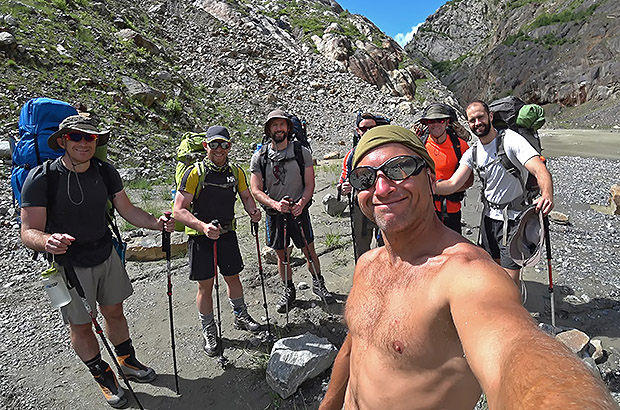
On an unserviced trekking route in Svanetia, Georgia
On such a route, participants are required to independently carry personal belongings, equipment and food, independently prepare food and perform other communal duties. As a rule, this is a more intense and physically demanding format of mountain travel.

On the trekking route in the area of Mount Bazarduzu in Dagestan
An example is our trekking program “Autumn Kamchatka”, the “Traverse of Ishinca” in Peru, the 8-day trekking program to the Antarctic Ice Sheet in Patagonia and similar (often quite hard) routes.
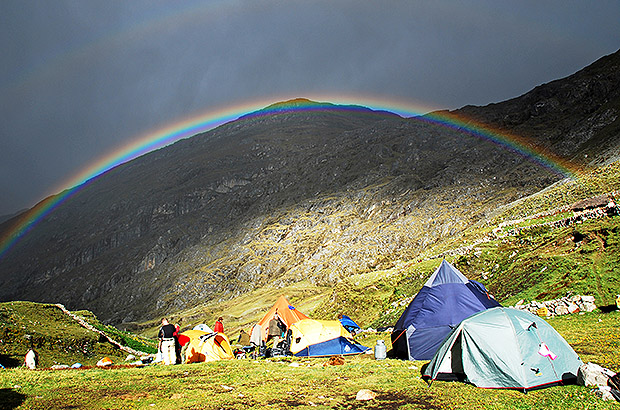
On the serviced trekking route in Cordillera Huayhuash, Peru
If we would to explain the concept of “trekking” in Russian terms, then the English word “trekking” roughly corresponds to Russian concept of mountain tourism, with some historical clarifications.
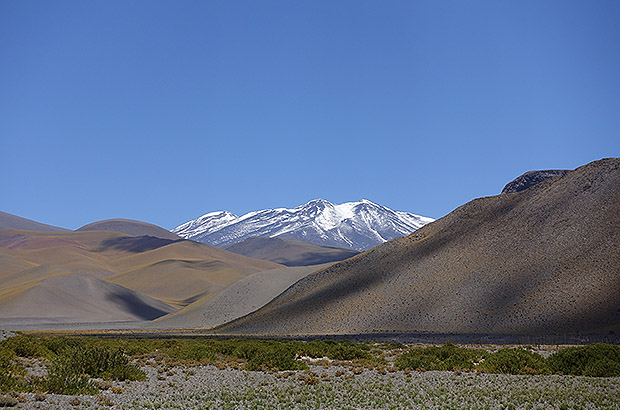
On the mountain trekking route to the top of Ojos del Salado, Argentina
During the Soviet era, mountain tourism, as a type of outdoor activity, was developed into independent sport and deliberately separated from mountaineering. In the Soviet format (which has no analogues in the global outdoor activity industry), mountain tourism has become a full-fledged sport, with its own Federation, a system of categories and titles, and a classification of routes. Various championships and competitions were held in mountain tourism, including “international” ones - with the participation of teams from different Soviet republics.

On the trekking route in eastern Georgia with 4x4 approach
At the same time, the routes of highest categories of difficulty in the mountain tourism, were connected with the need to overcome obstacles of a purely mountaineering nature, characteristic of high-category mountaineering routes both in technical and altitude class.
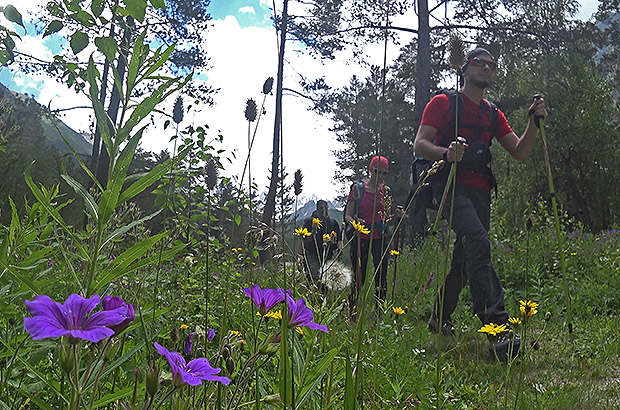
On the trekking route in the North Caucasus, Adyl Su region
The line dividing two types of mountain activities was the need or possibility of climbing the summit. If for mountaineering teams the main goal of the route was to climb to just the top, then mountain tourist groups were straightly prohibited from going to the summits. (Senseless prohibitions were a normal thing in the over formalized soviet system as a declaration of productive government activity)
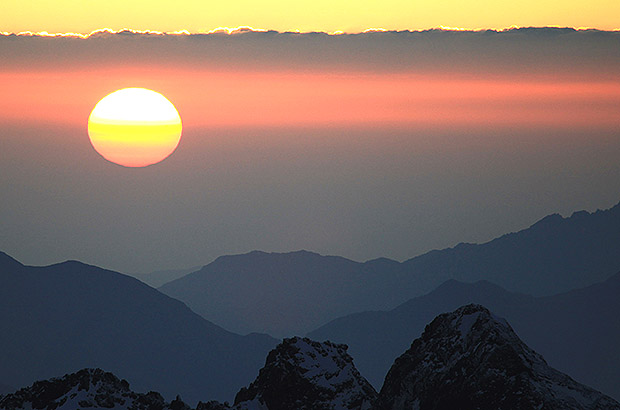
On the trekking route in the Atlas Mountains, Africa, Morocco
This division of outdoor activities and their formalization was a consequence of excessive bureaucratization in all spheres of life and leisure of USSR citizens. The formal separation of two very similar activities gave to the Soviet officials the opportunity to form extra bureaucratic structures, receive social bonuses and additional funding.
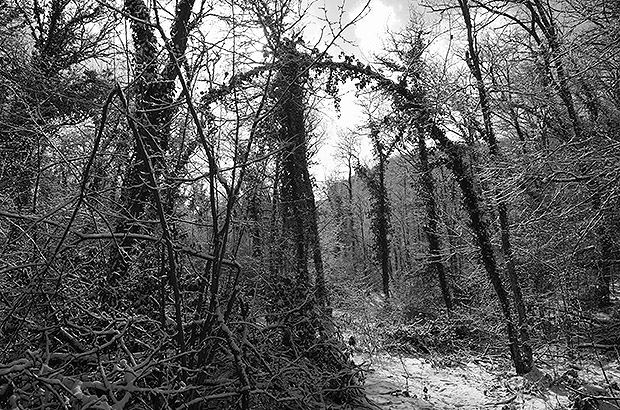
On the trekking route in the Crimean mountains
In practice, such formalization did not benefit any of both activities - the development of mountaineering and sports mountain tourism was slowed down by unnecessary formal complications and inevitable competition between artificially separated directions within the same sphere of mountain travel.
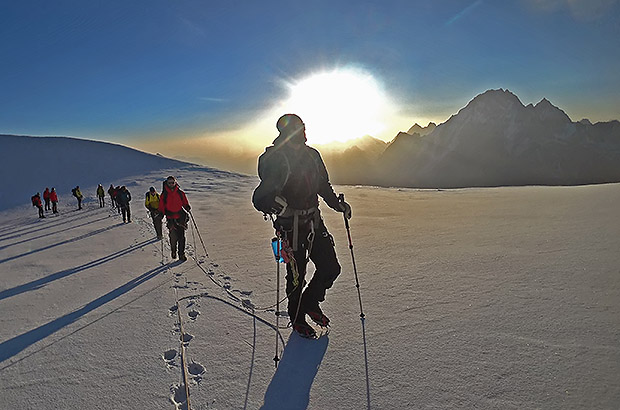
Regardless of the format of your trip, spending time in the mountains is the best way to break out of the circle of bustle and gray everyday life. Every minute spent in the mountains is your internal capital of positive emotions!
The consequences of this period in the history of Russia are still felt in the form of distorted motivation in mountaineering and numerous formalities that have no connection with the real level of development of modern international mountaineering as an important element of the global tourism industry.
The author of the text and photos - Alex Trubachev
Your mountaineering, iceclimbing and rockclimbing guide
MCS EDIT 2023
Our Principles
AlexClimb Rule #1 - Safety First
From the very beginning of our activity, here nearly 16 years, the first Principle of work of School of mountaineering and rock-climbing of MCS AlexClimb is the Safety Priority. On the basis of this Principle all process of training is based, all programs and rounds are developed and carried out only within this main principle. We consider that at professional approach to development of programs, at personal discipline and correctly put motivation - occupations by mountaineering and rock-climbing are COMPLETELY safe. And from the return - all troubles and accidents in our sport come from nonprofessionalism, from ignorance or neglect by elementary standards of safety, from irrational motivation, from revaluation of own forces and opportunities. All these prerequisites we COMPLETELY EXCLUDE in our work - ours Rock-climbing, Ice climbing and Mountaineering are based on one Principle - the Safety Priority. In rock-climbing, mountaineering and ice climbing, the Priority of Safety of MCS AlexClimb-is your personal security and comfort irrespective of, than we are engaged - we train muscles and we work technology of the movement in the sports hall and on the rock climbing wall, we make the way through snowstorm to top or we relax on golden sand of the Caribbean beach after hot day of trainings on rocks. The Safety priority - the main credo of School of mountaineering and rock-climbing of MCS AlexClimb.
AlexClimb Rule #2 - Leave No Trace
Closely interacting with Nature, working with the active programs in mountains, woods, lakes and rivers, we perfectly understand the importance of carefull and respectfull bahavior towards the Nature, for its resources. From the very beginning of our outdoor-activity we adopted rules of Leave No Trace technique - the standard of behavior of the person accepted in all the civilized world in relation to environment and especially - to the wild nature. After all on the relation of people to the nature near which they exist, itself can draw dalekoidushchy conclusions on the relation of these people to... Where and as we didn't travel - we don't reserve any garbage, we try to reduce whenever possible our influence on environment to a minimum. We clear earlier zagryazyonny tourist parking of the left garbage, we take out and we take out to utilization places that to us other people left there. We consider that only thus, at personal individual consciousness of each citizen, each tourist, climber or autotraveller, we will be able to keep the nature surrounding us in its state, natural, suitable for life, - in it pledge of the healthy future for ourselves and our children.





